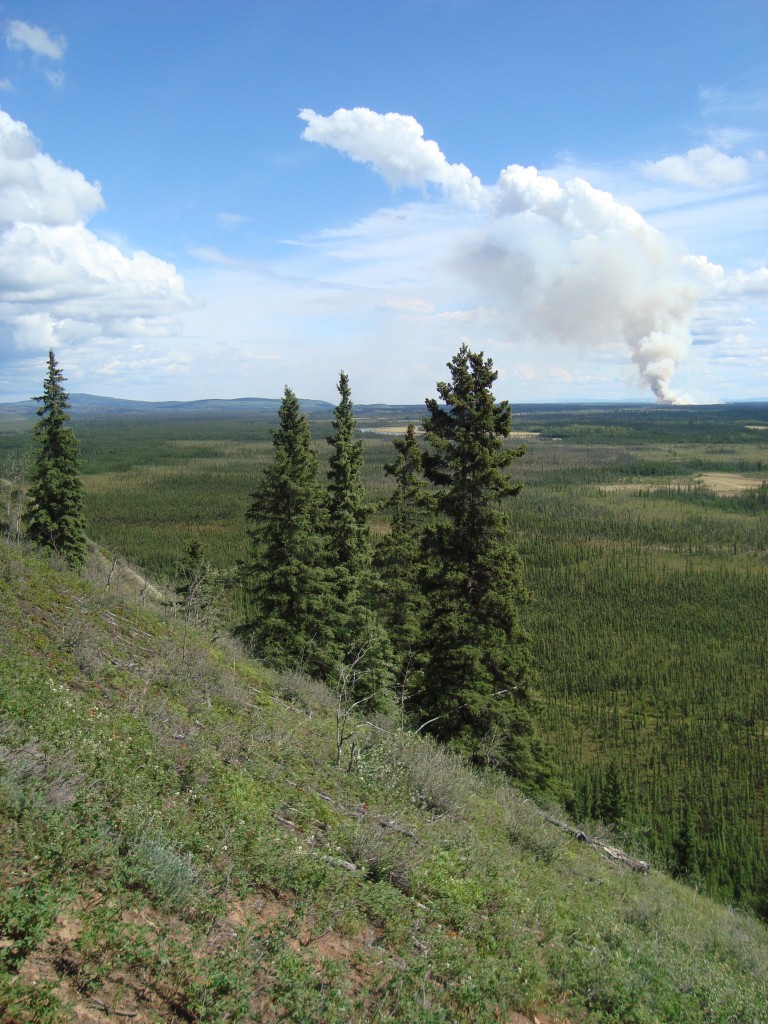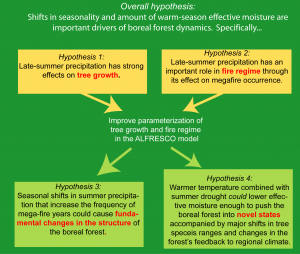Changing seasonality in the boreal forest
Overview (from NSF-ARC-0902088)
Co-PIs:
Link to the project website: https://sites.google.com/site/treeringseasonality/home
Link to a Scientific American blog post about talks Dan and Andi gave at AGU: http://www.scientificamerican.com/article.cfm?id=researcher-alaska-biological-regime-change
Both the timing and the magnitude of climatic events can have important impacts on ecological processes. Over the coming century, both the mean values of climate parameters (e.g., mean summer temperature) and the timing of seasonal events are predicted to change at high latitudes (Symon et al., 2005). In arctic and boreal ecosystems, important components of seasonality include the timing of spring snowmelt (Hinzman et al., 2006), the beginning and end of the fire season (Nitshcke and Innes, 2008), phenological events such as spring greenup (Delbart et al., 2008), and the seasonal break-up and formation of ice, both in lakes and the ocean (Serreze et al., 2000). In high-latitude ecosystems where seasonal changes are rapid and radical, even slight shifts in seasonality can trigger large ecosystem responses. In this research project, we test the hypothesis that the timing of warm-season precipitation is a key driver of both forest growth and fire regimes in high-latitude, boreal forest ecosystems. In turn, forest growth and fire regime in the boreal forest regulate feedbacks that have impacts on climate change at global scales (Chapin et al., 2005; McGuire et al., 2006).
Though low temperature is the most obvious limiting factor for life at high latitudes, there is increasing evidence that moisture limitations can also be important, particularly in the boreal forest. Evidence for moisture limitations acting within boreal landscapes comes from several sources, including satellite-derived indices of plant productivity (Normalized Difference Vegetation Index, NDVI; Goetz et al., 2005; Bunn et al., 2007), drought severity indices (Patric and Black, 1968), estimates of actual and potential evapotranspiration rates (Barber and Finney, 2000), and retrospective data from tree rings (Barber et al., 2000; Lloyd et al., 2002; Lloyd and Bunn 2007; D’Arrigo et al., 2008). Sweeping compositional changes in the boreal forest like the spread of black spruce in Alaska 5,000 years ago have also been linked to changes in moisture availability (Hu et al., 2006; Lloyd et al., 2006; Higuera et al., in press). Paleoecological time series of δ 18O in lake carbonates (Hu et al., 1993; Anderson et al., 2005) and prehistoric lake-levels (Abbott et al., 2000) suggest that moisture balance has been an important, and in some cases, been a limiting factor in a variety of boreal ecosystems during prehistory. Similarly, reconstruction of dune-field histories suggests that parts of the boreal forest have existed near moisture-controlled tipping points in their vegetation cover during the last 10,000 years (Mann et al., 2002). All these studies suggest that drought stress can be an important variable limiting plant growth in specific habitats within the boreal forest.
Moisture balance depends on both the amount and the seasonal distribution of precipitation inputs and evaporative losses. The importance of the seasonal distribution of moisture is especially pronounced in the boreal forest, where the growing season is short, transitions between seasons are rapid, and differences between growing and dormant seasons are extreme. In Interior Alaska, the growing season is typically <45 days, and the recharge of soil moisture is limited to about two weeks during spring snowmelt and two-months in late summer and early autumn (Carey and Quinton, 2005; Hinzman et al., 2006). The narrowness of these seasonal windows suggests a priori that moisture balance could be vulnerable to slight shifts in seasonality caused by changing climate.
We hypothesize that shifts in the seasonality and amount of warm-season precipitation are important drivers of several crucial ecosystem processes operating in the boreal forest of Interior Alaska. Specifically, we suspect there are strong ties between the seasonality of warm-season precipitation and the fire regime, in particular the incidence of the rare “mega-fire” seasons that account for most of the area burned at decadal time scales. Furthermore, we hypothesize that the seasonality and magnitude of warm-season rainfall influence the growth of boreal trees in a variety of topographic and altitudinal settings, and that it is the primary cause of the ‘temperature-induced drought stress’ that is currently affecting tree growth at many sites in Alaska. If these hypotheses are supported, changes in the seasonality of summer rainfall could have serious impacts on species’ geographical ranges and on their local abundances as climate changes during the next century. Equipped with this new knowledge, we will be better able to plan for the impacts of future climate changes in the global boreal forest.
This research has been supported by the National Science Foundation. Any opinions, findings, conclusions, or recommendations expressed in the material are those of the author(s) and do not necessarily reflect the views of the supporting agencies or the program as a whole.


Leave a Reply
You must be logged in to post a comment.